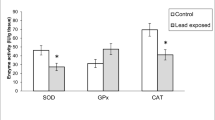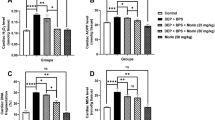Abstract
Because of the extensive use of phthalates for domestic, medical, and industrial applications, the evaluation of their toxic effects is of major concern to public health. The aim of the present study was to assess the propensity of di (2-ethylhexyl) phthalate (DEHP), one of the most used phthalates, to cause oxidative cardiac damage in mice. DEHP was administered intraperitoneally at doses of 5, 50, and 200 mg/kg body weight for 30 consecutive days in BALB/c mice. We assessed the effect of DEHP on cardiac injury using biochemical profile (such as aspartate aminotransferase (AST), alanine aminotransferase (ALT), lactate dehydrogenase (LDH), creatinine phosphokinase (CPK), total cholesterol (T-CHOL), triglyceride (TG), high-density lipoprotein cholesterol (HDL-C), and low-density lipoprotein cholesterol (LDL-C)), parameters related to myocardiac oxidative stress, such as malondialdehyde (MDA) level, protein carbonyl (PC) concentration, and DNA fragmentation. In addition, we evaluated antioxidant status; enzymatic (catalase (CAT) and superoxide dismutase (SOD) activities) and non-enzymatic (protein-bound sulfhydryl concentration (PSH)) antioxidants. Acetylcholinesterase (AChE) activity and histopathological changes were also assessed in heart mice treated with DEHP. Our results showed that DEHP induced an elevation of serum marker enzymes and perturbated the lipid profile. In addition, this phthalate increased lipid peroxidation, protein carbonyl levels, and DNA fragmentation in the heart in a dose-dependent manner. Antioxidant status was also perturbated by the increase of the CAT and SOD activities and the decrease of the protein-bound sulfhydryl concentration. AChE activity was also inhibited in the heart following the treatment with DEHP. These biochemical alterations were also confirmed by histopathological changes. Increased free radical production at various doses of DEHP would result in impairment of the redox status leading to an enhanced dose-dependent cardiotoxicity.








Similar content being viewed by others
References
Acay A, Ulu MS, Ahsen A, Ozkececi G, Demir K, Ozuguz U, Yuksel S, Acarturk G (2014) Atherogenic index as a predictor of atherosclerosis in subjects with familial Mediterranean fever. Medicina 50:329–333
Acuna LG, Calderon IL, Elias AO, Castro ME, Vasquez CC (2009) Expression of the ygg E gene protects Escherichia coli from potassium tellurite-generated oxidative stress. Arch Microbiol 191:473–476
Chaâbane M, Tir M, Hamdi S, Boudawara O, Jamoussi K, Boudawara T, Ghorbel E, Zeghal N, Soudani N (2016) Improvement of heart redox states contributes to the beneficial effects of selenium against penconazole-induced cardiotoxicity in adult rats. Biol Trace Elem Res 169:261–270
Chen HP, Pan MH, Chou YY, Sung C, Lee KH, Leung CM, Hsu PC (2017) Effects of di(2-ethylhexyl) phthalate exposure on 1,2-dimethyhydrazine-induced colon tumor promotion in rats. Food Chem Toxicol 103:157–167
Collins AR, Dusinska M, Gedik CM, Stetina R (1996) Oxidative damage to DNA: do we have a reliable biomarker. Environ Health Perspect 104(Supp 4):465–469
Diamanti-Kandarakis E, Bourguignon JP, Giudice LC, Hauser R, Prins GS, Soto AM, Zoeller RT, Gore AC (2009) Endocrine-disrupting chemicals: an Endocrine Society scientific statement. Endocr Rev 30:293–342
Dobiášová M, Frohlich J, Šedová M, Cheung MC, Brown BG (2011) Cholesterol esterification and atherogenic index of plasma correlate with lipoprotein size and findings on coronary angiography. J Lipid Res 52(3):566–571
Doull J, Cattley R, Elcombe C, Lake BG, Swenberg J, Wilkinson C, Williams G, van G M (1999) A cancer risk assessment of di(2-ethylhexyl)phthalate: application of the new US EPA risk assessment guidelines. Regul Toxicol Pharmacol 29:327–357
Du ZH, Xia J, Sun XC, Li XN, Zhang C, Zhao HS, Zhu SY, Li JL (2017) A novel nuclear xenobiotic receptors (AhR/PXR/CAR)-mediated mechanism of DEHP-induced cerebellar toxicity in quails (Coturnix japonica) via disrupting CYP enzyme system homeostasis. Environ Pollut 226:435–443
Eckl PM, Ortner A, Esterbauer H (1993) Genotoxic properties of 4-hydroxyalkenals and analogous aldehydes. Mutat Res 290:183–192
Eder E, Wacker M, Lutz U, Nair J, Fang X, Bartsch H, Beland F, Schlatter J, Lutz W (2006) Oxidative stress related DNA adducts in the liver of female rats fed with sunflower, rapeseed, olive- or coconut oil supplemented diets. Chem Biol Interact 159:81–89
Ellman GL, Courtney KD, Andres V, Featherstone R (1961) A new and rapid colorimetric determination of acetyl cholinesterase activity. Biochem Pharmacol 7:88–95
Gillum N, Karabekian Z, Swift LM, Brown RP, Kay MW, Sarvazyan N (2009) Clinically relevant concentrations of di (2-ethylhexyl) phthalate (DEHP) uncouple cardiac syncytium. Toxicol Appl Pharmacol 236:25–38
Green R, Hauser R, Calafat AM, Weuve J, Schettler T, Ringer S, Huttner K, and Hu H (2005) Use of Di(2-ethylhexyl) Phthalate–Containing Medical Products and Urinary Levels of Mono(2-ethylhexyl) Phthalate in Neonatal Intensive Care Unit Infants. Environ Health Perspect 113:1222–1225
Ha M, Wei L, Guan X, Li L, Liu C (2016) p53-dependent apoptosis contributes to di-(2-ethylhexyl) phthalate-induced hepatotoxicity. Environ Pollut 208:416–425
Han D, Hanawa N, Saberi B, Kaplowitz N (2006) Mechanisms of liver injury. III. Role of glutathione redox status in liver injury. Am J Physiol Gastrointest Liver Physiol 291:G1–G7
Heistad DD (2006) Oxidative stress and vascular disease: 2005 Duff lecture. Arterioscler Thromb Vasc Biol 26:689–695
Hoover DB, Ganote CE, Ferguson SM, Blakely RD, Parsons RL (2004) Localization of cholinergic innervation in guinea pig heart by immunohistochemistry for high-affinity choline transporters. Cardiovasc Res 62:112–121
Jaimes R, Swiercz A, Sherman M, Muselimyan N, Marvar PJ, Posnack NG (2017) Plastics and cardiovascular health: phthalates may disrupt heart rate variability and cardiovascular reactivity. Am J Physiol Heart Circ Physiol 313:H1044–H1053
Jawalekar SL, Kulkarni UJ, Surve VT, Deshmukh YA (2010) Status of lipid profile, MDA and protein carbonyl in patients with cardiovascular diseases. Arch Appl Sci Res 2:8–14
Kasai H, Kumeno K, Yamaizumi Z, Nishimura S, Nagao M, Fujita Y (1982) Mutagenicity of methylglyoxal in coffee. Gann 73:681–683
Kavlock R, Boekelheide K, Chapin R, Cunningham M, Faustman E, Foster P, Golub M, Henderson R, Hinberg I, Little R, Seed J, Shea K, Tabacova S, Tyl R, Williams P, Zacharewski T (2002) NTP center for the evaluation of risks to human reproduction: phthalates expert panel report on the reproductive and developmental toxicity of di(2-ethylhexyl) phthalate. Reprod Toxicol 16:529–653
Khalil N, Ebert JR, Wang L, Belcher S, Lee M, Czerwinski SA, Kannan K (2013) Bisphenol A and cardiometabolic risk factors in obese children. Sci Total Environ 470–471C:726–732
Kismali G, Yurdakok-Dikmen B, Kuzukiran O, Arslan P, Filazi A (2017) Di-(2-ethylhexyl) phthalate induced toxicity in prostate cancer cell lines and effects of alpha lipoic acid. Bratisl Lek Listy 118:460–466
Lefkowitz RJ, Hoffman BB, Taylor P (1996) Neurotransmission: the autonomic and somatic motor nervous systems. In: Hardman JG, Limbird LL, Molinoff PB, Ruddon RW, Gilman AG (eds) Goodman and Gilman’s the pharmacological basis of therapeutics, 9th edn. McGraw-Hill, New York, pp 105–139
Ma Y, Guo Y, Wu S, Lv Z, Zhang Q, Xie X, Ke Y (2018) Analysis of toxicity effects of di-(2-ethylhexyl) phthalate exposure on human bronchial epithelial 16HBE cells. Cytotechnology 70:119–128
Marklund S, Marklund G (1974) Involvement of the superoxide anion radical in the autoxidation of pyrogallol and a convenient assay for superoxide dismutase. Eur J Biochem 47:469–474
Marnett LJ, Hurd HK, Hollstein MC, Levin DE, Esterbauer H, Ames BN (1985) Naturally occurring carbonyl compounds are mutagens in Salmonella tester strain TA104. Mutat Res 148:25–34
Martinez-Arguelles DB, McIntosh M, Rohlicek CV, Culty M, Zirkin BR, Papadopoulos V (2013) Maternal in utero exposure to the endocrine disruptor di-(2-ethylhexyl) phthalate affects the blood pressure of adult male offspring. Toxicol Appl Pharmacol 266:95–100
Mateen S, Moin S, Khan AQ, Zafar A, Fatima N (2016) Increased reactive oxygen species formation and oxidative stress in rheumatoid arthritis. PLoS One 11:e0152925
Mediene-Benchekor S, Brousseau T, Richard F, Benhamamouch S, Amouyel P (2001) Blood lipid concentrations and risk of myocardial infarction. Lancet 358:1064–1065
Mello AS, Garcia CS, Machado FS, Medeiros NS, Wohlenberg MF, Marinho JP, Dani C, Funchal C, Coelho JC (2015) Oxidative stress parameters of Gaucher disease type I patients. Mol Genet Metab Rep 4:1–5
Melzer D, Rice NE, Lewis C, Henley WE, Galloway TS (2010) Association of urinary bisphenol a concentration with heart disease: evidence from NHANES 2003/06. PLoS One 5:e8673
Mercier Y, Gatellier P, Renerre M (2004) Lipid and protein oxidation in vitro, and antioxidant potential in meat from Charolais cows finished on pasture or mixed diet. Meat Sci 66:467–473
Ohkawa H, Ohishi N, Yagi K (1979) Assay for lipid peroxide in animal tissues by thiobarbituric acid reaction. Anal Biochem 95:351–358
Panagiotakos B, Pitsavos C, Skoumas J, Chrysohoou C, Toutouza M, Stefanadis CI, Toutouzas PK (2003) Importance of LDL/HDL ratio as a predicator for coronary heart disease events in patients with heterozygous familial hypercholesterolemia: a 15-year follow up (1987–2002). Curr Med Res Opin 19:89–94
Patsch JR (1993) Plasma triglycerides and high-density lipoprotein. In: Catapano AI, Bernini F, Corsini A (eds) High-density lipoprotein: physiopathology and clinical relevance. Raven Press Ltd, New York, p 139
Posnack NG (2014) The adverse cardiac effects of Di(2-ethylhexyl) phthalate and bisphenol A. Cardiovasc Toxicol 14(4):339–357
Posnack NG, Lee NH, Brown R, Sarvazyan N (2011) Gene expression profiling of DEHP-treated cardiomyocytes reveals potential causes of phthalate arrhythmogenicity. Toxicology 279:54–64
Pradhan A, Olsson PE, Jass J (2018) Di(2-ethylhexyl) phthalate and diethyl phthalate disrupt lipid metabolism, reduce fecundity and shortens lifespan of Caenorhabditis elegans. Chemosphere 190:375–382
Sedlack I, Lindsay RH (1968) Estimation of total, protein-bound and non-protein bound sulfhydryl groups in tissue with Ellman’s reagent. Anal Biochem 25:192–205
Sheela-Sasikumar C, Shyamala-Devi CS (2000) Protective effect of Abana, a polyherbal formulation, on isoproterenol induced myocardial infarction in rats. Indian J Pharmacol 32:198–201
Sohal RS, Weindruch R (1996) Oxidative stress, caloric restriction and aging. Science 273:59–63
Sun L, Zang WJ, Wang H, Zhao M, Yu XJ, He X, Miao Y, Zhou J (2014) Acetylcholine promotes ROS detoxification against hypoxia/reoxygenation-induced oxidative stress through FoxO3a/PGC-1α dependent superoxide dismutase. Cell Physiol Biochem 34(5):1614–1625
Sunmonu TO, Afolayan AJ (2010) Protective effect of Artemisia afra Jacq. on isoproterenol-induced myocardial injury in Wistar rats. Food Chem Toxicol 48(7):1969–1972
Thomas JA, Darby TD, Wallin RF, Garvin PJ, Martis L (1978) A review of the biological effects of di-(2-ethylhexyl) phthalate. Toxicol Appl Pharmacol 45:1–27
Tickner JA, Schettler T, Guidotti T, McCally M, Rossi M (2001) Health risks posed by use of di-2-ethylhexyl phthalate (DEHP) in PVC medical devices: a critical review. Am J Ind Med 39:100–111
Tsakiris S, Angelogianni P, Schulpis KH, Stavridis C (2000) Protective effect of L-phenylalanine on rat brain acetylcholinesterase inhibition induced by free radicals. Clin Biochem 33:103–106
Tsutsui H, Kinugawa S, Matsushima S (2011) Oxidative stress and heart failure. Am J Physiol Heart Circ Physiol 301(6):H2181–H2190
Wang X, Jiang L, Ge L, Chen M, Yang G, Ji F, Zhong L, Guan Y, Liu X (2015) Oxidative DNA damage induced bydi-(2-ethylhexyl) phthalate in HEK-293 cell line. Environ Toxicol Pharmacol 39:1099–1106
Wang Y, Chen B, Lin T, Wu S, Wei G (2017) Protective effects of vitamin E against reproductive toxicity induced by di(2ethylhexyl) phthalate via PPAR-dependent mechanisms. Toxicol Mech Methods 27:551–559
Author information
Authors and Affiliations
Corresponding author
Additional information
Responsible editor: Philippe Garrigues
Publisher’s note
Springer Nature remains neutral with regard to jurisdictional claims in published maps and institutional affiliations.
Rights and permissions
About this article
Cite this article
Amara, I., Timoumi, R., Annabi, E. et al. Di (2-ethylhexyl) phthalate induces cardiac disorders in BALB/c mice. Environ Sci Pollut Res 26, 7540–7549 (2019). https://doi.org/10.1007/s11356-019-04219-w
Received:
Accepted:
Published:
Issue Date:
DOI: https://doi.org/10.1007/s11356-019-04219-w




